Biofertilizer Market SIZE & SHARE ANALYSIS – GROWTH TRENDS & FORECASTS UP TO 2030
The Biofertilizer Market is segmented by Form (Azospirillum, Azotobacter, Mycorrhiza, Phosphate Solubilizing Bacteria, Rhizobium), by Crop Type (Cash Crops, Horticultural Crops, Row Crops) and by Region (Africa, Asia-Pacific, Europe, Middle East, North America, South America). The report offers market size in both market value in USD and market volume in metric ton. Further, the report includes market split by form and various crop types.
Biofertilizer Market SIZE & SHARE ANALYSIS – GROWTH TRENDS & FORECASTS UP TO 2030
Biofertilizer Market Size
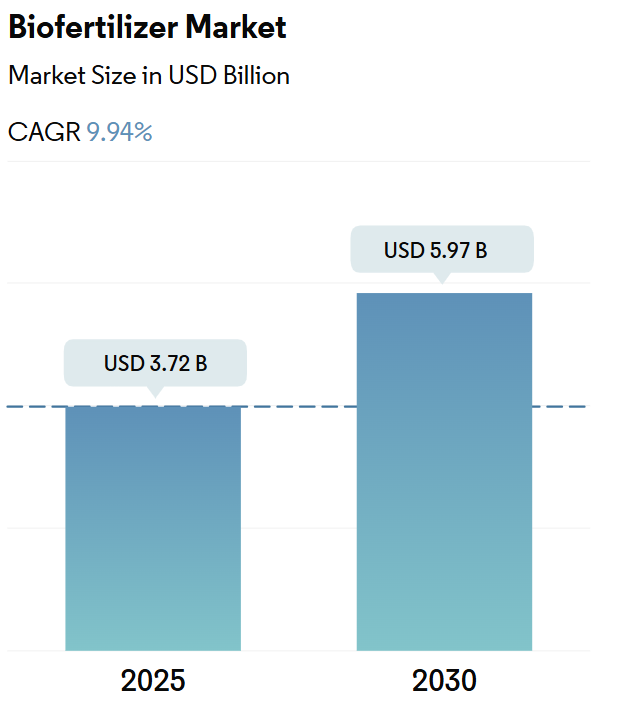
Key Players
Compare market size and growth of Biofertilizer Market with other markets in Agriculture Industry
Seeds
Crop Protection
Fertilizers
Agricultural Commodities
Agriculture Services
Agricultural Machinery and Technology
Biofertilizer Market SIZE & SHARE ANALYSIS – GROWTH TRENDS & FORECASTS UP TO 2030
| Study Period: | 2017 – 2030 |
| CAGR: | 9.94% (2025 – 2030) |
| Countries/ Region Covered: | Africa, Asia-Pacific, Europe, Middle East, North America, South America |
| Major Players: | Agronutrition, Biolchim SPA, Koppert Biological Systems Inc., Lallemand, Symborg, Inc. |
Biofertilizer Market Analysis
The Biofertilizer Market size is estimated at 3.72 billion USD in 2025, and is expected to reach 5.97 billion USD by 2030, growing at a CAGR of 9.94% during the forecast period (2025-2030).
3.72 Billion
Market Size in 2025 (USD)
5.97 Billion
Market Size in 2030 (USD)
7.13 %
CAGR (2017-2024)
9.94 %
CAGR (2025-2030)
Largest by Form
36.66 %
value share, Mycorrhiza, 2024
Mycorrhiza, also referred to as Arbuscular mycorrhizal fungi (AMF), was proven to increase crop yields significantly. It is the most consumed biofertilizer globally.
Fastest by Form
10.75 %
Projected CAGR, Rhizobium, 2025-2030
Rhizobium is the most important nitrogen-fixing bacterium that exists in a symbiotic relationship with plants and lives in the root nodules of leguminous plants.
Largest by Crop Type
75.12 %
value share, Row Crops, 2024
The major row crops grown around the world include rice, barley, corn, wheat, rapeseed, rye, soybean, etc. and they accounted for 74.6% of biofertilizer consumption in 2022.
Largest by Region
34.84 %
value share, North America, 2024
The area under cultivation of organic crops in the region had increased by 13.5% during the historic period from 1.4 million hectares in 2017 to 1.6 million hectares in 2021.
Leading Market Player
15.89 %
market share, Indian Farmers Fertiliser Cooperative Limited,
Indian Farmers Fertiliser Cooperative Limited(IFFCO) has a global presence through associations and partnerships in Asia-Pacific, South-East Asia, the Middle East, and Europe.
- Biofertilizers are living microorganisms that can enhance plant nutrition by either mobilizing or increasing nutrient availability in soils. The most common microorganisms used as biofertilizers in agriculture include mycorrhiza, Azospirillum, Azotobacter, Rhizobium, and phosphate-solubilizing bacteria.
- Among these, mycorrhiza is the most consumed biofertilizer globally. It accounted for 36.7% of the biofertilizer segment in 2022, with a market value of USD 1.04 billion and a volume of 170.6 thousand metric tons. Mycorrhiza increases the root surface area of plants, thus enhancing their nutrient uptake.
- Rhizobium is the second most consumed biofertilizer globally. It accounted for 24.2% of the biofertilizer segment in 2022. North America dominated the rhizobium sub-segment with a market share of 52.1% in the same year. Row crops dominated the rhizobium sub-segment in North America, accounting for 62.4% in 2022. Rhizobium has a symbiotic association with leguminous crops, a category of row crops. Thus, row crops dominated the rhizobium sub-segment. North America also has a large cultivation area of row crops. The rhizobium sub-segment in the North American row crops market is anticipated to record a CAGR of 10.5% during the forecast period.
- Azospirillum accounted for 16.3% of the biofertilizer segment. North America dominated the Azospirillum sub-segment, accounting for 45.7% in 2022.
- Thus, the biofertilizer segment of the global agricultural biologicals market is expected to grow in the coming years as more farmers seek sustainable and eco-friendly solutions to improve crop yields and soil health.
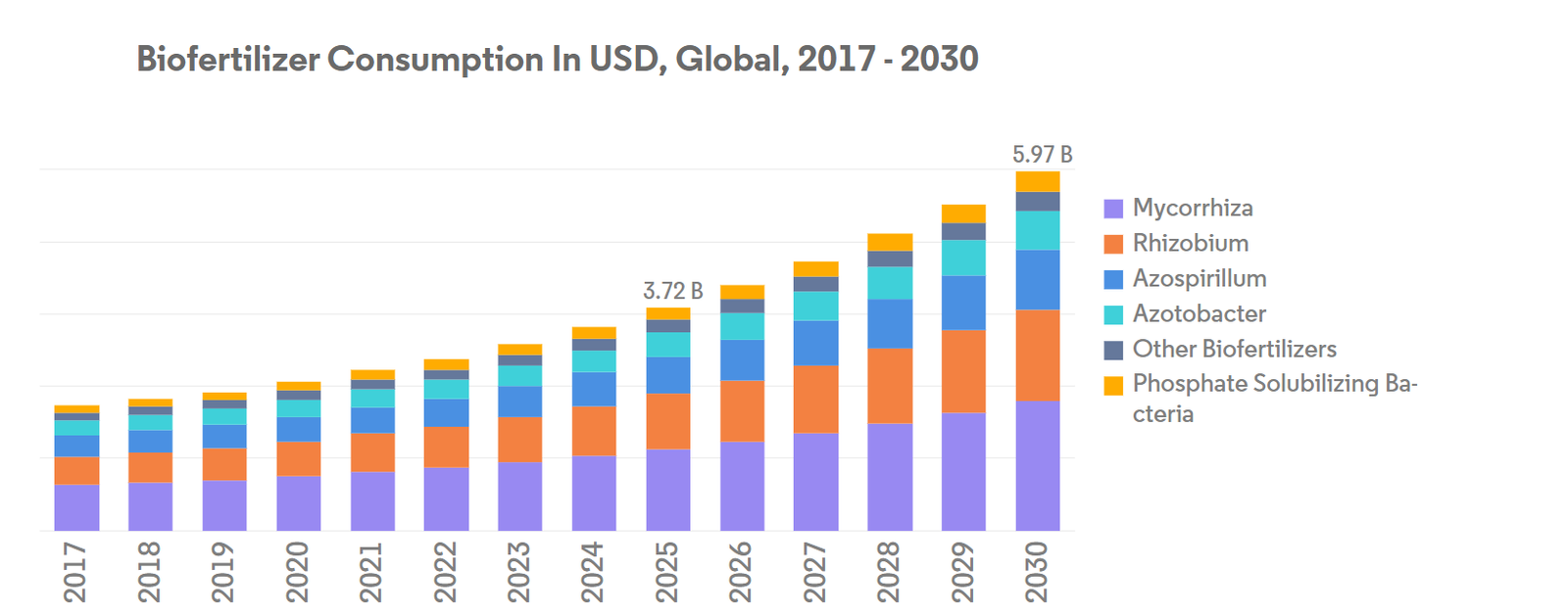
- Biofertilizers are living microorganisms that have the ability to enhance plant nutrition by either mobilizing or increasing nutrient availability in soils. North America and Europe are the major consumers of biofertilizers in the world.
- North America accounted for 34.5% of the global biofertilizer market in 2022. The area under cultivation of organic crops in the region increased by 13.5% during the historical period, from 1.4 million hectares in 2017 to 1.6 million hectares in 2021. The demand for organic food in the region is growing rapidly, with an average per capita spending on organic food products in North America at USD 109.7 in 2021.
- The European region accounted for 30.7% in 2022 and stood as the second-largest consumer of biofertilizers. Europe had the largest area under organic farming in the world, with 6.5 million hectares in 2021. The European Commission has unveiled an action plan to increase the organic area in the member countries to occupy 25.0% of the region’s agricultural land area by 2030. This factor is further expected to drive the market for biofertilizers in the region.
- The Asia-Pacific region is a leading producer of organic crops such as rice, sugarcane, and fruits and vegetables. China and India are emerging leaders, although organic farming only accounts for a small portion of their total agricultural area. The organic farming area in the region grew from 2017 to 2021, and this trend is expected to drive growth in the biofertilizer market.
- The increasing organic crop area and increasing demand for organic commodities across the world, particularly in regions like Europe and North America, may drive the demand for biofertilizers during the forecast period.
Global Biofertilizer Market Trends
Organic production is at an all-time high in North America and Europe, due to the increasing awareness and Government initiatives.
- Organic agriculture has emerged as a significant contributor to sustainable food systems, with 187 countries practicing it globally. As of 2021, there was 72.3 million ha of organic agricultural land worldwide, with an average increase of 2.9% across all regions from 2018 to 2021. Organic arable land accounted for 14.4 million ha, representing 19.9% of the total organic agricultural land.
- The strongest markets for organic farming are North America and Europe, accounting for 41.0% of the global organic arable land. In 2022, Europe had 6.5 million ha of organic arable land, equivalent to 44.1% of the overall organic arable agricultural area. The most significant crops grown organically in North America and Europe are apples, strawberries, cereals, and olives.
- Developing countries in Asia-Pacific are also joining the organic agriculture movement and becoming self-sufficient in producing and providing fresh organic produce to meet their domestic demand. The trend of organic farming is gaining momentum in Asia-Pacific, with the region recording an 18.8% increase in organic arable land from 2017 to 2022. The major initiatives by governments in the region also play a vital role in the growing trend of organic farming. For example, Japan’s Basic Plan for Food, Agriculture, and Rural Areas aims to triple the number of organic farmers and lands by 2030.
- The growth of organic agriculture is driven by the rising awareness of the benefits of organic farming, such as promoting soil health, reducing environmental impacts, and producing healthier food.
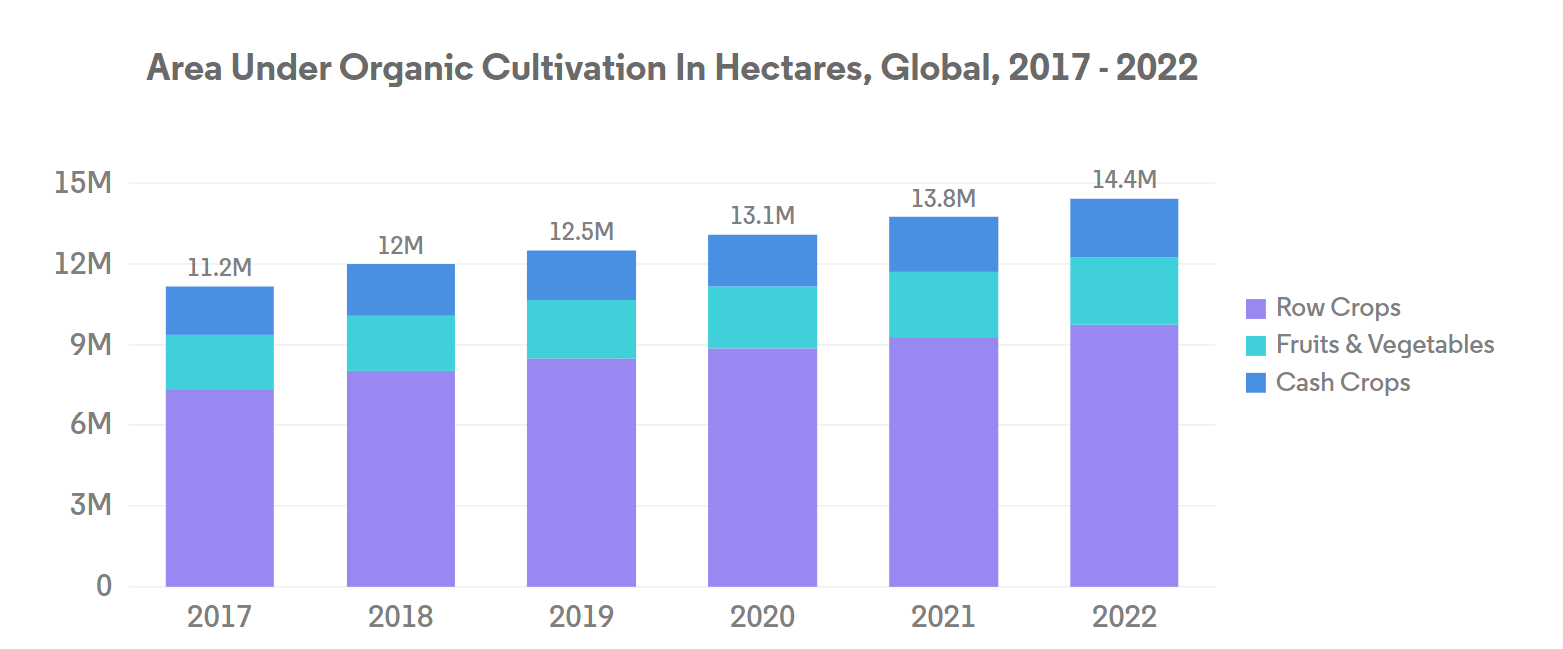
Per capita spending of organic food majorly observed in United States and Germany, attributed to the consumer demand for healthier and sustainable food
- The organic food market experienced significant growth in the past few years, with global sales reaching USD 120.6 billion in 2020, up from USD 70.8 billion in 2012. The trend toward organic food is being driven by several factors, such as increasing consumer demand for healthier, more sustainable food options and a growing awareness of the environmental impact of conventional agriculture. The global organic food market is expected to continue its growth trend over the coming years.
- According to a survey conducted by the Organic Trade Association in 2021, sales of organic fruits and vegetables increased by around 4.5% in the same year, accounting for 15% of the overall organic sales. North America dominates the market in terms of average spending on organic products, with per capita spending in the United States reaching USD 186.7 in 2021, the highest among all North American countries. Europe is also expected to experience significant growth in the organic food market, with Germany accounting for the highest per capita spending of USD 75.6 in 2021.
- While the organic food market is still dominated by developed countries with high consumer disposable incomes, it is also expected to grow in developing nations. For example, the increasing number of working-class people in the Asia-Pacific region may contribute to the market’s expansion due to the growing availability and affordability of organic food products.
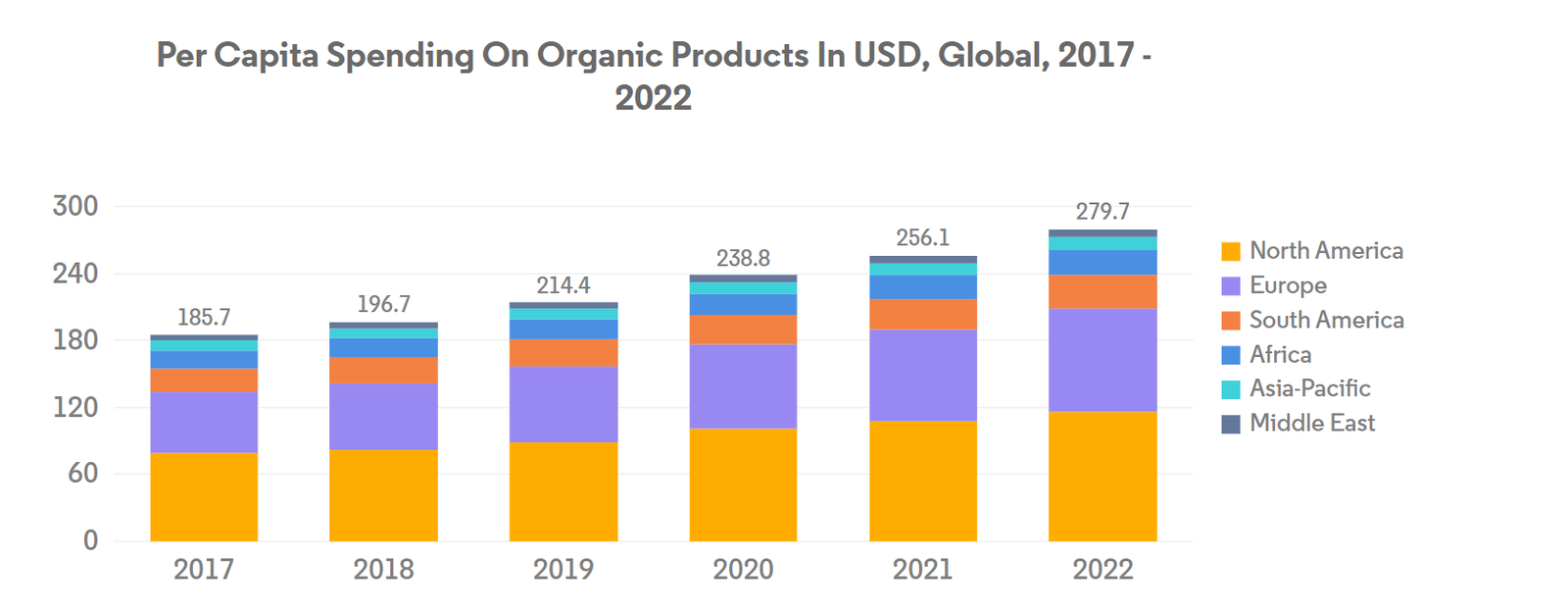
Biofertilizer Industry Overview
The Biofertilizer Market is fragmented, with the top five companies occupying 21.14%. The major players in this market are Gujarat State Fertilizers & Chemicals Ltd, Indian Farmers Fertiliser Cooperative Limited, Koppert Biological Systems Inc., Symborg Inc. and T.Stanes and Company Limited (sorted alphabetically).
Biofertilizer Market Leaders
- Gujarat State Fertilizers & Chemicals Ltd
- Indian Farmers Fertiliser Cooperative Limited
- Koppert Biological Systems Inc.
- Symborg Inc.
- T.Stanes and Company Limited
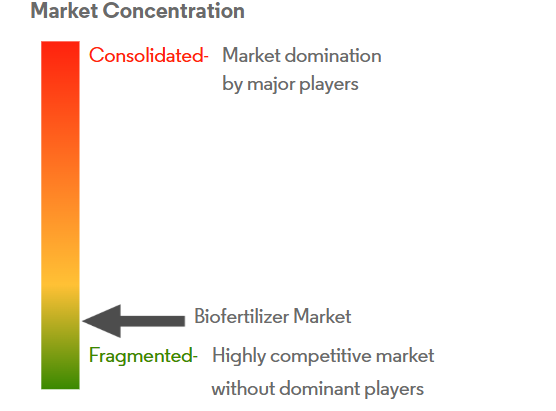
Other important companies include Andermatt Group AG, Atlántica Agrícola, Binzhou Jingyang Biological Fertilizer Co. Ltd, Biostadt India Limited, Ficosterra, Indogulf BioAg LLC (Biotech Division of Indogulf Company), IPL Biologicals Limited, Kiwa Bio-Tech, Microbial Biological Fertilizers International, Suståne Natural Fertilizer Inc.
Biofertilizer Market News
- October 2022: Koppert intends to invest in three new production units in Brazil, ensuring its leadership in the Brazilian and global markets for biological agricultural inputs. The new formulation unit will be located on more than 8,000 m2. It will produce the entire microbiological line, including products based on viruses, fungi, and bacteria in liquid or solid formulations.
- September 2022: Corteva Agriscience agreed to acquire Symborg Inc. to strengthen its global presence with a strong distribution network.
- March 2021: Symborg opened a new hydrolysis plant in Spain, with a total investment of USD 28.0 million. The plant is designed for the manufacturing of sustainable products for agriculture, such as biofertilizers, biostimulants, and biocontrol solutions that are imported to the United States.
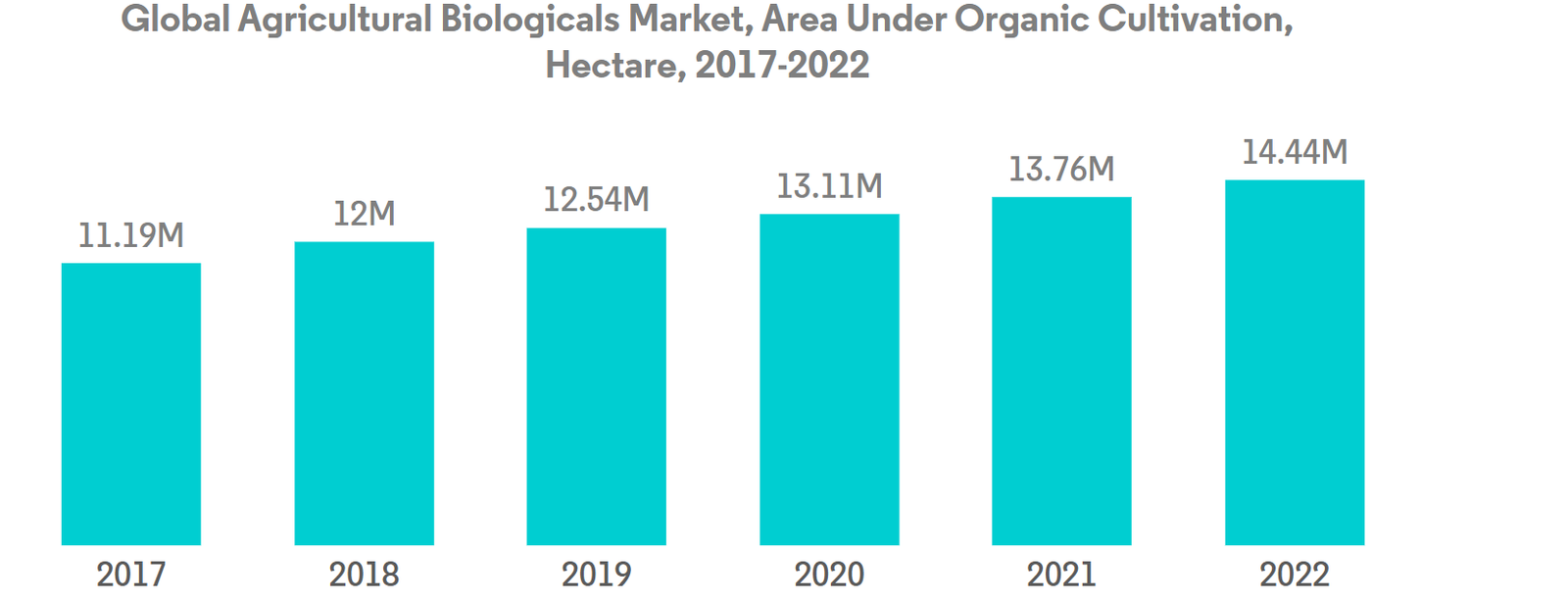
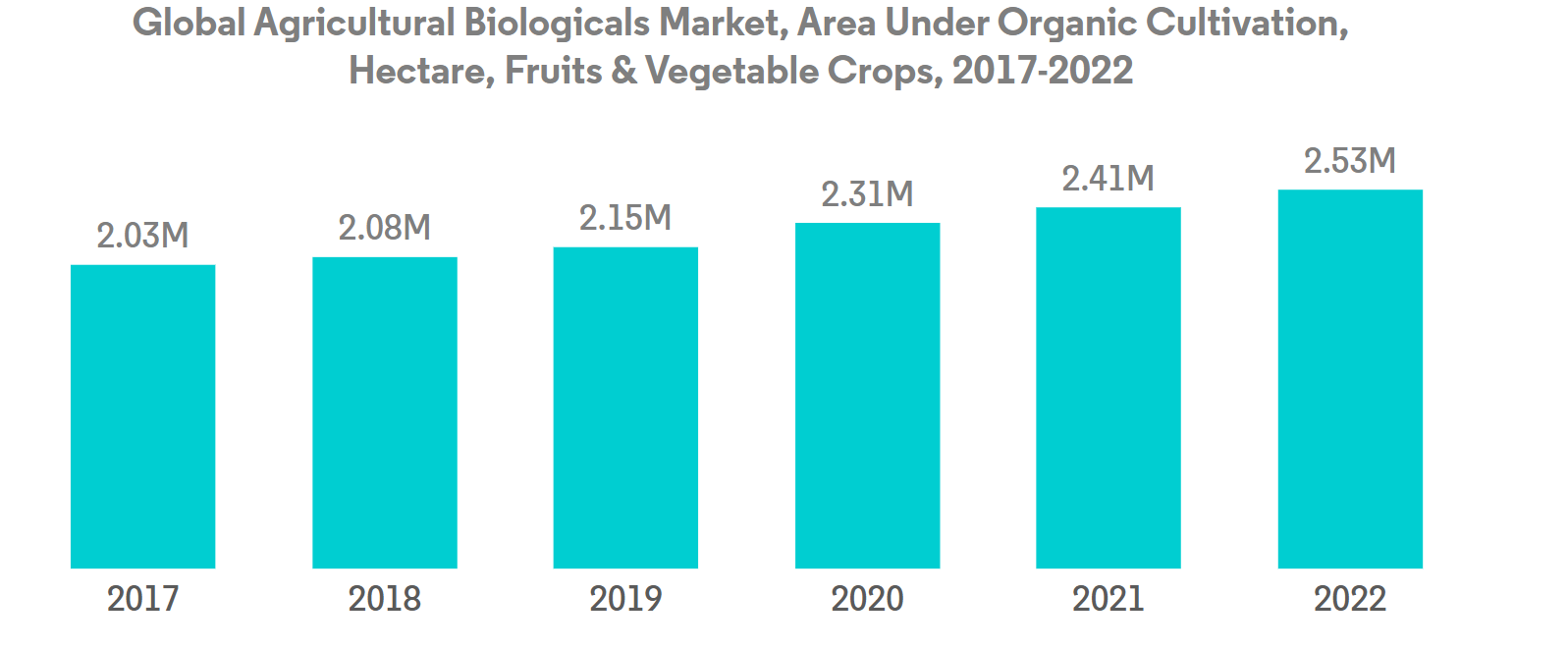
Biofertilizer Market Report – Table of Contents
1. EXECUTIVE SUMMARY & KEY FINDINGS
2. REPORT OFFERS
3. INTRODUCTION
- 3.1 Study Assumptions & Market Definition
- 3.2 Scope of the Study
- 3.3 Research Methodology
4. KEY INDUSTRY TRENDS
- 4.1 Area Under Organic Cultivation
- 4.2 Per Capita Spending On Organic Products
- 4.3 Regulatory Framework
- 4.3.1 Argentina
- 4.3.2 Australia
- 4.3.3 Brazil
- 4.3.4 Canada
- 4.3.5 China
- 4.3.6 Egypt
- 4.3.7 France
- 4.3.8 Germany
- 4.3.9 India
- 4.3.10 Indonesia
- 4.3.11 Iran
- 4.3.12 Italy
- 4.3.13 Japan
- 4.3.14 Mexico
- 4.3.15 Netherlands
- 4.3.16 Nigeria
- 4.3.17 Philippines
- 4.3.18 Russia
- 4.3.19 South Africa
- 4.3.20 Spain
- 4.3.21 Thailand
- 4.3.22 Turkey
- 4.3.23 United Kingdom
- 4.3.24 United States
- 4.3.25 Vietnam
- 4.4 Value Chain & Distribution Channel Analysis
5. MARKET SEGMENTATION (includes market size in Value in USD and Volume, Forecasts up to 2030 and analysis of growth prospects)
- 5.1 Form
- 5.1.1 Azospirillum
- 5.1.2 Azotobacter
- 5.1.3 Mycorrhiza
- 5.1.4 Phosphate Solubilizing Bacteria
- 5.1.5 Rhizobium
- 5.1.6 Other Biofertilizers
- 5.2 Crop Type
- 5.2.1 Cash Crops
- 5.2.2 Horticultural Crops
- 5.2.3 Row Crops
- 5.3 Region
- 5.3.1 Africa
- 5.3.1.1 By Country
- 5.3.1.1.1 Egypt
- 5.3.1.1.2 Nigeria
- 5.3.1.1.3 South Africa
- 5.3.1.1.4 Rest of Africa
- 5.3.2 Asia-Pacific
- 5.3.2.1 By Country
- 5.3.2.1.1 Australia
- 5.3.2.1.2 China
- 5.3.2.1.3 India
- 5.3.2.1.4 Indonesia
- 5.3.2.1.5 Japan
- 5.3.2.1.6 Philippines
- 5.3.2.1.7 Thailand
- 5.3.2.1.8 Vietnam
- 5.3.2.1.9 Rest of Asia-Pacific
- 5.3.3 Europe
- 5.3.3.1 By Country
- 5.3.3.1.1 France
- 5.3.3.1.2 Germany
- 5.3.3.1.3 Italy
- 5.3.3.1.4 Netherlands
- 5.3.3.1.5 Russia
- 5.3.3.1.6 Spain
- 5.3.3.1.7 Turkey
- 5.3.3.1.8 United Kingdom
- 5.3.3.1.9 Rest of Europe
- 5.3.4 Middle East
- 5.3.4.1 By Country
- 5.3.4.1.1 Iran
- 5.3.4.1.2 Saudi Arabia
- 5.3.4.1.3 Rest of Middle East
- 5.3.5 North America
- 5.3.5.1 By Country
- 5.3.5.1.1 Canada
- 5.3.5.1.2 Mexico
- 5.3.5.1.3 United States
- 5.3.5.1.4 Rest of North America
- 5.3.6 South America
- 5.3.6.1 By Country
- 5.3.6.1.1 Argentina
- 5.3.6.1.2 Brazil
- 5.3.6.1.3 Rest of South America
6. COMPETITIVE LANDSCAPE
- 6.1 Key Strategic Moves
- 6.2 Market Share Analysis
- 6.3 Company Landscape
- 6.4 Company Profiles (includes Global Level Overview, Market Level Overview, Core Business Segments, Financials, Headcount, Key Information, Market Rank, Market Share, Products and Services, and Analysis of Recent Developments).
- 6.4.1 Andermatt Group AG
- 6.4.2 Atlántica Agrícola
- 6.4.3 Binzhou Jingyang Biological Fertilizer Co. Ltd
- 6.4.4 Biostadt India Limited
- 6.4.5 Ficosterra
- 6.4.6 Gujarat State Fertilizers & Chemicals Ltd
- 6.4.7 Indian Farmers Fertiliser Cooperative Limited
- 6.4.8 Indogulf BioAg LLC (Biotech Division of Indogulf Company)
- 6.4.9 IPL Biologicals Limited
- 6.4.10 Kiwa Bio-Tech
- 6.4.11 Koppert Biological Systems Inc.
- 6.4.12 Microbial Biological Fertilizers International
- 6.4.13 Suståne Natural Fertilizer Inc.
- 6.4.14 Symborg Inc.
- 6.4.15 T.Stanes and Company Limited
7. KEY STRATEGIC QUESTIONS FOR AGRICULTURAL BIOLOGICALS CEOS
8. APPENDIX
- 8.1 Global Overview
- 8.1.1 Overview
- 8.1.2 Porter’s Five Forces Framework
- 8.1.3 Global Value Chain Analysis
- 8.1.4 Market Dynamics (DROs)
- 8.2 Sources & References
- 8.3 List of Tables & Figures
- 8.4 Primary Insights
- 8.5 Data Pack
- 8.6 Glossary of Terms
List of Tables & Figures
- Figure 1:
- AREA UNDER ORGANIC CULTIVATION IN HECTARES, GLOBAL, 2017 – 2022
- Figure 2:
- PER CAPITA SPENDING ON ORGANIC PRODUCTS IN USD, GLOBAL, 2017 – 2022
- Figure 3:
- GLOBAL BIOFERTILIZER MARKET, VOLUME, METRIC TON, 2017 – 2029
- Figure 4:
- GLOBAL BIOFERTILIZER MARKET, VALUE, USD, 2017 – 2029
- Figure 5:
- BIOFERTILIZER CONSUMPTION IN METRIC TON, GLOBAL, 2017 – 2029
- Figure 6:
- BIOFERTILIZER CONSUMPTION IN USD, GLOBAL, 2017 – 2029
- Figure 7:
- BIOFERTILIZER CONSUMPTION VOLUME BY FORM IN %, GLOBAL, 2017 VS 2023 VS 2029
- Figure 8:
- BIOFERTILIZER CONSUMPTION VALUE BY FORM IN %, GLOBAL, 2017 VS 2023 VS 2029
- Figure 9:
- AZOSPIRILLUM CONSUMPTION IN METRIC TON, GLOBAL, 2017 – 2029
- Figure 10:
- AZOSPIRILLUM CONSUMPTION IN USD, GLOBAL, 2017 – 2029
- Figure 11:
- AZOSPIRILLUM CONSUMPTION VALUE BY CROP TYPE IN %, GLOBAL, 2022 VS 2029
- Figure 12:
- AZOTOBACTER CONSUMPTION IN METRIC TON, GLOBAL, 2017 – 2029
- Figure 13:
- AZOTOBACTER CONSUMPTION IN USD, GLOBAL, 2017 – 2029
- Figure 14:
- AZOTOBACTER CONSUMPTION VALUE BY CROP TYPE IN %, GLOBAL, 2022 VS 2029
- Figure 15:
- MYCORRHIZA CONSUMPTION IN METRIC TON, GLOBAL, 2017 – 2029
- Figure 16:
- MYCORRHIZA CONSUMPTION IN USD, GLOBAL, 2017 – 2029
- Figure 17:
- MYCORRHIZA CONSUMPTION VALUE BY CROP TYPE IN %, GLOBAL, 2022 VS 2029
- Figure 18:
- PHOSPHATE SOLUBILIZING BACTERIA CONSUMPTION IN METRIC TON, GLOBAL, 2017 – 2029
- Figure 19:
- PHOSPHATE SOLUBILIZING BACTERIA CONSUMPTION IN USD, GLOBAL, 2017 – 2029
- Figure 20:
- PHOSPHATE SOLUBILIZING BACTERIA CONSUMPTION VALUE BY CROP TYPE IN %, GLOBAL, 2022 VS 2029
- Figure 21:
- RHIZOBIUM CONSUMPTION IN METRIC TON, GLOBAL, 2017 – 2029
- Figure 22:
- RHIZOBIUM CONSUMPTION IN USD, GLOBAL, 2017 – 2029
- Figure 23:
- RHIZOBIUM CONSUMPTION VALUE BY CROP TYPE IN %, GLOBAL, 2022 VS 2029
- Figure 24:
- OTHER BIOFERTILIZERS CONSUMPTION IN METRIC TON, GLOBAL, 2017 – 2029
- Figure 25:
- OTHER BIOFERTILIZERS CONSUMPTION IN USD, GLOBAL, 2017 – 2029
- Figure 26:
- OTHER BIOFERTILIZERS CONSUMPTION VALUE BY CROP TYPE IN %, GLOBAL, 2022 VS 2029
- Figure 27:
- BIOFERTILIZER CONSUMPTION IN METRIC TON, GLOBAL, 2017 – 2029
- Figure 28:
- BIOFERTILIZER CONSUMPTION IN USD, GLOBAL, 2017 – 2029
- Figure 29:
- BIOFERTILIZER CONSUMPTION VOLUME BY CROP TYPE IN %, GLOBAL, 2017 VS 2023 VS 2029
- Figure 30:
- BIOFERTILIZER CONSUMPTION VALUE BY CROP TYPE IN %, GLOBAL, 2017 VS 2023 VS 2029
- Figure 31:
- BIOFERTILIZER CONSUMPTION BY CASH CROPS IN METRIC TON, GLOBAL, 2017 – 2029
- Figure 32:
- BIOFERTILIZER CONSUMPTION BY CASH CROPS IN USD, GLOBAL, 2017 – 2029
- Figure 33:
- BIOFERTILIZER CONSUMPTION VALUE BY FORM IN %, GLOBAL, 2022 VS 2029
- Figure 34:
- BIOFERTILIZER CONSUMPTION BY HORTICULTURAL CROPS IN METRIC TON, GLOBAL, 2017 – 2029
- Figure 35:
- BIOFERTILIZER CONSUMPTION BY HORTICULTURAL CROPS IN USD, GLOBAL, 2017 – 2029
- Figure 36:
- BIOFERTILIZER CONSUMPTION VALUE BY FORM IN %, GLOBAL, 2022 VS 2029
- Figure 37:
- BIOFERTILIZER CONSUMPTION BY ROW CROPS IN METRIC TON, GLOBAL, 2017 – 2029
- Figure 38:
- BIOFERTILIZER CONSUMPTION BY ROW CROPS IN USD, GLOBAL, 2017 – 2029
- Figure 39:
- BIOFERTILIZER CONSUMPTION VALUE BY FORM IN %, GLOBAL, 2022 VS 2029
- Figure 40:
- BIOFERTILIZER CONSUMPTION IN METRIC TON, GLOBAL, 2017 – 2029
- Figure 41:
- BIOFERTILIZER CONSUMPTION IN USD, GLOBAL, 2017 – 2029
- Figure 42:
- BIOFERTILIZER CONSUMPTION VOLUME BY REGION IN %, GLOBAL, 2017 VS 2023 VS 2029
- Figure 43:
- BIOFERTILIZER CONSUMPTION VALUE BY REGION IN %, GLOBAL, 2017 VS 2023 VS 2029
- Figure 44:
- BIOFERTILIZER CONSUMPTION IN METRIC TON, AFRICA, 2017 – 2029
- Figure 45:
- BIOFERTILIZER CONSUMPTION IN USD, AFRICA, 2017 – 2029
- Figure 46:
- BIOFERTILIZER CONSUMPTION VOLUME BY COUNTRY IN %, AFRICA, 2017 VS 2023 VS 2029
- Figure 47:
- BIOFERTILIZER CONSUMPTION VALUE BY COUNTRY IN %, AFRICA, 2017 VS 2023 VS 2029
- Figure 48:
- BIOFERTILIZER CONSUMPTION IN METRIC TON, EGYPT, 2017 – 2029
- Figure 49:
- BIOFERTILIZER CONSUMPTION IN USD, EGYPT, 2017 – 2029
- Figure 50:
- BIOFERTILIZER CONSUMPTION VALUE BY FORM IN %, EGYPT, 2022 VS 2029
- Figure 51:
- BIOFERTILIZER CONSUMPTION IN METRIC TON, NIGERIA, 2017 – 2029
- Figure 52:
- BIOFERTILIZER CONSUMPTION IN USD, NIGERIA, 2017 – 2029
- Figure 53:
- BIOFERTILIZER CONSUMPTION VALUE BY FORM IN %, NIGERIA, 2022 VS 2029
- Figure 54:
- BIOFERTILIZER CONSUMPTION IN METRIC TON, SOUTH AFRICA, 2017 – 2029
- Figure 55:
- BIOFERTILIZER CONSUMPTION IN USD, SOUTH AFRICA, 2017 – 2029
- Figure 56:
- BIOFERTILIZER CONSUMPTION VALUE BY FORM IN %, SOUTH AFRICA, 2022 VS 2029
- Figure 57:
- BIOFERTILIZER CONSUMPTION IN METRIC TON, REST OF AFRICA, 2017 – 2029
- Figure 58:
- BIOFERTILIZER CONSUMPTION IN USD, REST OF AFRICA, 2017 – 2029
- Figure 59:
- BIOFERTILIZER CONSUMPTION VALUE BY FORM IN %, REST OF AFRICA, 2022 VS 2029
- Figure 60:
- BIOFERTILIZER CONSUMPTION IN METRIC TON, ASIA-PACIFIC, 2017 – 2029
- Figure 61:
- BIOFERTILIZER CONSUMPTION IN USD, ASIA-PACIFIC, 2017 – 2029
- Figure 62:
- BIOFERTILIZER CONSUMPTION VOLUME BY COUNTRY IN %, ASIA-PACIFIC, 2017 VS 2023 VS 2029
- Figure 63:
- BIOFERTILIZER CONSUMPTION VALUE BY COUNTRY IN %, ASIA-PACIFIC, 2017 VS 2023 VS 2029
- Figure 64:
- BIOFERTILIZER CONSUMPTION IN METRIC TON, AUSTRALIA, 2017 – 2029
- Figure 65:
- BIOFERTILIZER CONSUMPTION IN USD, AUSTRALIA, 2017 – 2029
- Figure 66:
- BIOFERTILIZER CONSUMPTION VALUE BY FORM IN %, AUSTRALIA, 2022 VS 2029
- Figure 67:
- BIOFERTILIZER CONSUMPTION IN METRIC TON, CHINA, 2017 – 2029
- Figure 68:
- BIOFERTILIZER CONSUMPTION IN USD, CHINA, 2017 – 2029
- Figure 69:
- BIOFERTILIZER CONSUMPTION VALUE BY FORM IN %, CHINA, 2022 VS 2029
- Figure 70:
- BIOFERTILIZER CONSUMPTION IN METRIC TON, INDIA, 2016 – 2029
- Figure 71:
- BIOFERTILIZER CONSUMPTION IN USD, INDIA, 2016 – 2029
- Figure 72:
- BIOFERTILIZER CONSUMPTION VALUE BY FORM IN %, INDIA, 2022 VS 2029
- Figure 73:
- BIOFERTILIZER CONSUMPTION IN METRIC TON, INDONESIA, 2017 – 2029
- Figure 74:
- BIOFERTILIZER CONSUMPTION IN USD, INDONESIA, 2017 – 2029
- Figure 75:
- BIOFERTILIZER CONSUMPTION VALUE BY FORM IN %, INDONESIA, 2022 VS 2029
- Figure 76:
- BIOFERTILIZER CONSUMPTION IN METRIC TON, JAPAN, 2017 – 2029
- Figure 77:
- BIOFERTILIZER CONSUMPTION IN USD, JAPAN, 2017 – 2029
- Figure 78:
- BIOFERTILIZER CONSUMPTION VALUE BY FORM IN %, JAPAN, 2022 VS 2029
- Figure 79:
- BIOFERTILIZER CONSUMPTION IN METRIC TON, PHILIPPINES, 2017 – 2029
- Figure 80:
- BIOFERTILIZER CONSUMPTION IN USD, PHILIPPINES, 2017 – 2029
- Figure 81:
- BIOFERTILIZER CONSUMPTION VALUE BY FORM IN %, PHILIPPINES, 2022 VS 2029
- Figure 82:
- BIOFERTILIZER CONSUMPTION IN METRIC TON, THAILAND, 2017 – 2029
- Figure 83:
- BIOFERTILIZER CONSUMPTION IN USD, THAILAND, 2017 – 2029
- Figure 84:
- BIOFERTILIZER CONSUMPTION VALUE BY FORM IN %, THAILAND, 2022 VS 2029
- Figure 85:
- BIOFERTILIZER CONSUMPTION IN METRIC TON, VIETNAM, 2017 – 2029
- Figure 86:
- BIOFERTILIZER CONSUMPTION IN USD, VIETNAM, 2017 – 2029
- Figure 87:
- BIOFERTILIZER CONSUMPTION VALUE BY FORM IN %, VIETNAM, 2022 VS 2029
- Figure 88:
- BIOFERTILIZER CONSUMPTION IN METRIC TON, REST OF ASIA-PACIFIC, 2017 – 2029
- Figure 89:
- BIOFERTILIZER CONSUMPTION IN USD, REST OF ASIA-PACIFIC, 2017 – 2029
- Figure 90:
- BIOFERTILIZER CONSUMPTION VALUE BY FORM IN %, REST OF ASIA-PACIFIC, 2022 VS 2029
- Figure 91:
- BIOFERTILIZER CONSUMPTION IN METRIC TON, EUROPE, 2017 – 2029
- Figure 92:
- BIOFERTILIZER CONSUMPTION IN USD, EUROPE, 2017 – 2029
- Figure 93:
- BIOFERTILIZER CONSUMPTION VOLUME BY COUNTRY IN %, EUROPE, 2017 VS 2023 VS 2029
- Figure 94:
- BIOFERTILIZER CONSUMPTION VALUE BY COUNTRY IN %, EUROPE, 2017 VS 2023 VS 2029
- Figure 95:
- BIOFERTILIZER CONSUMPTION IN METRIC TON, FRANCE, 2017 – 2029
- Figure 96:
- BIOFERTILIZER CONSUMPTION IN USD, FRANCE, 2017 – 2029
- Figure 97:
- BIOFERTILIZER CONSUMPTION VALUE BY FORM IN %, FRANCE, 2022 VS 2029
- Figure 98:
- BIOFERTILIZER CONSUMPTION IN METRIC TON, GERMANY, 2017 – 2029
- Figure 99:
- BIOFERTILIZER CONSUMPTION IN USD, GERMANY, 2017 – 2029
- Figure 100:
- BIOFERTILIZER CONSUMPTION VALUE BY FORM IN %, GERMANY, 2022 VS 2029
- Figure 101:
- BIOFERTILIZER CONSUMPTION IN METRIC TON, ITALY, 2017 – 2029
- Figure 102:
- BIOFERTILIZER CONSUMPTION IN USD, ITALY, 2017 – 2029
- Figure 103:
- BIOFERTILIZER CONSUMPTION VALUE BY FORM IN %, ITALY, 2022 VS 2029
- Figure 104:
- BIOFERTILIZER CONSUMPTION IN METRIC TON, NETHERLANDS, 2017 – 2029
- Figure 105:
- BIOFERTILIZER CONSUMPTION IN USD, NETHERLANDS, 2017 – 2029
- Figure 106:
- BIOFERTILIZER CONSUMPTION VALUE BY FORM IN %, NETHERLANDS, 2022 VS 2029
- Figure 107:
- BIOFERTILIZER CONSUMPTION IN METRIC TON, RUSSIA, 2017 – 2029
- Figure 108:
- BIOFERTILIZER CONSUMPTION IN USD, RUSSIA, 2017 – 2029
- Figure 109:
- BIOFERTILIZER CONSUMPTION VALUE BY FORM IN %, RUSSIA, 2022 VS 2029
- Figure 110:
- BIOFERTILIZER CONSUMPTION IN METRIC TON, SPAIN, 2017 – 2029
- Figure 111:
- BIOFERTILIZER CONSUMPTION IN USD, SPAIN, 2017 – 2029
- Figure 112:
- BIOFERTILIZER CONSUMPTION VALUE BY FORM IN %, SPAIN, 2022 VS 2029
- Figure 113:
- BIOFERTILIZER CONSUMPTION IN METRIC TON, TURKEY, 2017 – 2029
- Figure 114:
- BIOFERTILIZER CONSUMPTION IN USD, TURKEY, 2017 – 2029
- Figure 115:
- BIOFERTILIZER CONSUMPTION VALUE BY FORM IN %, TURKEY, 2022 VS 2029
- Figure 116:
- BIOFERTILIZER CONSUMPTION IN METRIC TON, UNITED KINGDOM, 2017 – 2029
- Figure 117:
- BIOFERTILIZER CONSUMPTION IN USD, UNITED KINGDOM, 2017 – 2029
- Figure 118:
- BIOFERTILIZER CONSUMPTION VALUE BY FORM IN %, UNITED KINGDOM, 2022 VS 2029
- Figure 119:
- BIOFERTILIZER CONSUMPTION IN METRIC TON, REST OF EUROPE, 2017 – 2029
- Figure 120:
- BIOFERTILIZER CONSUMPTION IN USD, REST OF EUROPE, 2017 – 2029
- Figure 121:
- BIOFERTILIZER CONSUMPTION VALUE BY FORM IN %, REST OF EUROPE, 2022 VS 2029
- Figure 122:
- BIOFERTILIZER CONSUMPTION IN METRIC TON, MIDDLE EAST, 2017 – 2029
- Figure 123:
- BIOFERTILIZER CONSUMPTION IN USD, MIDDLE EAST, 2017 – 2029
- Figure 124:
- BIOFERTILIZER CONSUMPTION VOLUME BY COUNTRY IN %, MIDDLE EAST, 2017 VS 2023 VS 2029
- Figure 125:
- BIOFERTILIZER CONSUMPTION VALUE BY COUNTRY IN %, MIDDLE EAST, 2017 VS 2023 VS 2029
- Figure 126:
- BIOFERTILIZER CONSUMPTION IN METRIC TON, IRAN, 2017 – 2029
- Figure 127:
- BIOFERTILIZER CONSUMPTION IN USD, IRAN, 2017 – 2029
- Figure 128:
- BIOFERTILIZER CONSUMPTION VALUE BY FORM IN %, IRAN, 2022 VS 2029
- Figure 129:
- BIOFERTILIZER CONSUMPTION IN METRIC TON, SAUDI ARABIA, 2017 – 2029
- Figure 130:
- BIOFERTILIZER CONSUMPTION IN USD, SAUDI ARABIA, 2017 – 2029
- Figure 131:
- BIOFERTILIZER CONSUMPTION VALUE BY FORM IN %, SAUDI ARABIA, 2022 VS 2029
- Figure 132:
- BIOFERTILIZER CONSUMPTION IN METRIC TON, REST OF MIDDLE EAST, 2017 – 2029
- Figure 133:
- BIOFERTILIZER CONSUMPTION IN USD, REST OF MIDDLE EAST, 2017 – 2029
- Figure 134:
- BIOFERTILIZER CONSUMPTION VALUE BY FORM IN %, REST OF MIDDLE EAST, 2022 VS 2029
- Figure 135:
- BIOFERTILIZER CONSUMPTION IN METRIC TON, NORTH AMERICA, 2017 – 2029
- Figure 136:
- BIOFERTILIZER CONSUMPTION IN USD, NORTH AMERICA, 2017 – 2029
- Figure 137:
- BIOFERTILIZER CONSUMPTION VOLUME BY COUNTRY IN %, NORTH AMERICA, 2017 VS 2023 VS 2029
- Figure 138:
- BIOFERTILIZER CONSUMPTION VALUE BY COUNTRY IN %, NORTH AMERICA, 2017 VS 2023 VS 2029
- Figure 139:
- BIOFERTILIZER CONSUMPTION IN METRIC TON, CANADA, 2017 – 2029
- Figure 140:
- BIOFERTILIZER CONSUMPTION IN USD, CANADA, 2017 – 2029
- Figure 141:
- BIOFERTILIZER CONSUMPTION VALUE BY FORM IN %, CANADA, 2022 VS 2029
- Figure 142:
- BIOFERTILIZER CONSUMPTION IN METRIC TON, MEXICO, 2017 – 2029
- Figure 143:
- BIOFERTILIZER CONSUMPTION IN USD, MEXICO, 2017 – 2029
- Figure 144:
- BIOFERTILIZER CONSUMPTION VALUE BY FORM IN %, MEXICO, 2022 VS 2029
- Figure 145:
- BIOFERTILIZER CONSUMPTION IN METRIC TON, UNITED STATES, 2017 – 2029
- Figure 146:
- BIOFERTILIZER CONSUMPTION IN USD, UNITED STATES, 2017 – 2029
- Figure 147:
- BIOFERTILIZER CONSUMPTION VALUE BY FORM IN %, UNITED STATES, 2022 VS 2029
- Figure 148:
- BIOFERTILIZER CONSUMPTION IN METRIC TON, REST OF NORTH AMERICA, 2017 – 2029
- Figure 149:
- BIOFERTILIZER CONSUMPTION IN USD, REST OF NORTH AMERICA, 2017 – 2029
- Figure 150:
- BIOFERTILIZER CONSUMPTION VALUE BY FORM IN %, REST OF NORTH AMERICA, 2022 VS 2029
- Figure 151:
- BIOFERTILIZER CONSUMPTION IN METRIC TON, SOUTH AMERICA, 2017 – 2029
- Figure 152:
- BIOFERTILIZER CONSUMPTION IN USD, SOUTH AMERICA, 2017 – 2029
- Figure 153:
- BIOFERTILIZER CONSUMPTION VOLUME BY COUNTRY IN %, SOUTH AMERICA, 2017 VS 2023 VS 2029
- Figure 154:
- BIOFERTILIZER CONSUMPTION VALUE BY COUNTRY IN %, SOUTH AMERICA, 2017 VS 2023 VS 2029
- Figure 155:
- BIOFERTILIZER CONSUMPTION IN METRIC TON, ARGENTINA, 2017 – 2029
- Figure 156:
- BIOFERTILIZER CONSUMPTION IN USD, ARGENTINA, 2017 – 2029
- Figure 157:
- BIOFERTILIZER CONSUMPTION VALUE BY FORM IN %, ARGENTINA, 2022 VS 2029
- Figure 158:
- BIOFERTILIZER CONSUMPTION IN METRIC TON, BRAZIL, 2017 – 2029
- Figure 159:
- BIOFERTILIZER CONSUMPTION IN USD, BRAZIL, 2017 – 2029
- Figure 160:
- BIOFERTILIZER CONSUMPTION VALUE BY FORM IN %, BRAZIL, 2022 VS 2029
- Figure 161:
- BIOFERTILIZER CONSUMPTION IN METRIC TON, REST OF SOUTH AMERICA, 2017 – 2029
- Figure 162:
- BIOFERTILIZER CONSUMPTION IN USD, REST OF SOUTH AMERICA, 2017 – 2029
- Figure 163:
- BIOFERTILIZER CONSUMPTION VALUE BY FORM IN %, REST OF SOUTH AMERICA, 2022 VS 2029
- Figure 164:
- GLOBAL BIOFERTILIZER MARKET, MOST ACTIVE COMPANIES, BY NUMBER OF STRATEGIC MOVES, 2017-2022
- Figure 165:
- GLOBAL BIOFERTILIZER MARKET, MOST ADOPTED STRATEGIES, 2017-2022
- Figure 166:
- GLOBAL BIOFERTILIZER MARKET SHARE(%), BY MAJOR PLAYERS
Biofertilizer Industry Segmentation
Azospirillum, Azotobacter, Mycorrhiza, Phosphate Solubilizing Bacteria, Rhizobium are covered as segments by Form. Cash Crops, Horticultural Crops, Row Crops are covered as segments by Crop Type. Africa, Asia-Pacific, Europe, Middle East, North America, South America are covered as segments by Region.
- Biofertilizers are living microorganisms that can enhance plant nutrition by either mobilizing or increasing nutrient availability in soils. The most common microorganisms used as biofertilizers in agriculture include mycorrhiza, Azospirillum, Azotobacter, Rhizobium, and phosphate-solubilizing bacteria.
- Among these, mycorrhiza is the most consumed biofertilizer globally. It accounted for 36.7% of the biofertilizer segment in 2022, with a market value of USD 1.04 billion and a volume of 170.6 thousand metric tons. Mycorrhiza increases the root surface area of plants, thus enhancing their nutrient uptake.
- Rhizobium is the second most consumed biofertilizer globally. It accounted for 24.2% of the biofertilizer segment in 2022. North America dominated the rhizobium sub-segment with a market share of 52.1% in the same year. Row crops dominated the rhizobium sub-segment in North America, accounting for 62.4% in 2022. Rhizobium has a symbiotic association with leguminous crops, a category of row crops. Thus, row crops dominated the rhizobium sub-segment. North America also has a large cultivation area of row crops. The rhizobium sub-segment in the North American row crops market is anticipated to record a CAGR of 10.5% during the forecast period.
- Azospirillum accounted for 16.3% of the biofertilizer segment. North America dominated the Azospirillum sub-segment, accounting for 45.7% in 2022.
- Thus, the biofertilizer segment of the global agricultural biologicals market is expected to grow in the coming years as more farmers seek sustainable and eco-friendly solutions to improve crop yields and soil health.
| Form | Azospirillum | ||
| Azotobacter | |||
| Mycorrhiza | |||
| Phosphate Solubilizing Bacteria | |||
| Rhizobium | |||
| Other Biofertilizers | |||
| Crop Type | Cash Crops | ||
| Horticultural Crops | |||
| Row Crops | |||
| Region | Africa | By Country | Egypt |
| Nigeria | |||
| South Africa | |||
| Rest of Africa | |||
| Region | Asia-Pacific | By Country | Australia |
| China | |||
| India | |||
| Indonesia | |||
| Japan | |||
| Philippines | |||
| Thailand | |||
| Vietnam | |||
| Rest of Asia-Pacific | |||
| Region | Europe | By Country | France |
| Germany | |||
| Italy | |||
| Netherlands | |||
| Russia | |||
| Spain | |||
| Turkey | |||
| United Kingdom | |||
| Rest of Europe | |||
| Region | Middle East | By Country | Iran |
| Saudi Arabia | |||
| Rest of Middle East | |||
| Region | North America | By Country | Canada |
| Mexico | |||
| United States | |||
| Rest of North America | |||
| Region | South America | By Country | Argentina |
| Brazil | |||
| Rest of South America |
Market Definition
- AVERAGE DOSAGE RATE – The average application rate is the average volume of biofertilizers applied per hectare of farmland in the respective region/country.
- CROP TYPE – Crop type includes Row crops (Cereals, Pulses, Oilseeds), Horticultural Crops (Fruits and vegetables) and Cash Crops (Plantation Crops, Fibre Crops and Other Industrial Crops)
- FUNCTION – The crop nutrition function of agricultural biological consists of various products that provide essential plant nutrients and enhance soil quality.
- TYPE – Biofertilizers enhance soil quality by increasing the population of beneficial microorganisms. They help crops absorb nutrients from the environment.
| Keyword | Definition |
|---|---|
| Cash Crops | Cash crops are non-consumable crops sold as a whole or part of the crop to manufacture end-products to make a profit. |
| Integrated Pest Management (IPM) | IPM is an environment-friendly and sustainable approach to control pests in various crops. It involves a combination of methods, including biological controls, cultural practices, and selective use of pesticides. |
| Bacterial biocontrol agents | Bacteria used to control pests and diseases in crops. They work by producing toxins harmful to the target pests or competing with them for nutrients and space in the growing environment. Some examples of commonly used bacterial biocontrol agents include Bacillus thuringiensis (Bt), Pseudomonas fluorescens, and Streptomyces spp. |
| Plant Protection Product (PPP) | A plant protection product is a formulation applied to crops to protect from pests, such as weeds, diseases, or insects. They contain one or more active substances with other co-formulants such as solvents, carriers, inert material, wetting agents or adjuvants formulated to give optimum product efficacy. |
| Pathogen | A pathogen is an organism causing disease to its host, with the severity of the disease symptoms. |
| Parasitoids | Parasitoids are insects that lay their eggs on or within the host insect, with their larvae feeding on the host insect. In agriculture, parasitoids can be used as a form of biological pest control, as they help to control pest damage to crops and decrease the need for chemical pesticides. |
| Entomopathogenic Nematodes (EPN) | Entomopathogenic nematodes are parasitic roundworms that infect and kill pests by releasing bacteria from their gut. Entomopathogenic nematodes are a form of biocontrol agents used in agriculture. |
| Vesicular-arbuscular mycorrhiza (VAM) | VAM fungi are mycorrhizal species of fungus. They live in the roots of different higher-order plants. They develop a symbiotic relationship with the plants in the roots of these plants. |
| Fungal biocontrol agents | Fungal biocontrol agents are the beneficial fungi that control plant pests and diseases. They are an alternative to chemical pesticides. They infect and kill the pests or compete with pathogenic fungi for nutrients and space. |
| Biofertilizers | Biofertilizers contain beneficial microorganisms that enhance soil fertility and promote plant growth. |
| Biopesticides | Biopesticides are natural/bio-based compounds used to manage agricultural pests using specific biological effects. |
| Predators | Predators in agriculture are the organisms that feed on pests and help control pest damage to the crops. Some common predator species used in agriculture include ladybugs, lacewings, and predatory mites. |
| Biocontrol agents | Biocontrol agents are living organisms used to control pests and diseases in agriculture. They are alternatives to chemical pesticides and are known for their lesser impact on the environment and human health. |
| Organic Fertilizers | Organic fertilizer is composed of animal or vegetable matter used alone or in combination with one or more non-synthetically derived elements or compounds used for soil fertility and plant growth. |
| Protein hydrolysates (PHs) | Protein hydrolysate-based biostimulants contain free amino acids, oligopeptides, and polypeptides produced by enzymatic or chemical hydrolysis of proteins, primarily from vegetal or animal sources. |
| Biostimulants/Plant Growth Regulators (PGR) | Biostimulants/Plant Growth Regulators (PGR) are substances derived from natural resources to enhance plant growth and health by stimulating plant processes (metabolism). |
| Soil Amendments | Soil Amendments are substances applied to soil that improve soil health, such as soil fertility and soil structure. |
| Seaweed Extract | Seaweed extracts are rich in micro and macronutrients, proteins, polysaccharides, polyphenols, phytohormones, and osmolytes. These substances boost seed germination and crop establishment, total plant growth and productivity. |
| Compounds related to biocontrol and/or promoting growth (CRBPG) | Compounds related to biocontrol or promoting growth (CRBPG) are the ability of a bacteria to produce compounds for phytopathogen biocontrol and plant growth promotion. |
| Symbiotic Nitrogen-Fixing Bacteria | Symbiotic nitrogen-fixing bacteria such as Rhizobium obtain food and shelter from the host, and in return, they help by providing fixed nitrogen to the plants. |
| Nitrogen Fixation | Nitrogen fixation is a chemical process in soil which converts molecular nitrogen into ammonia or related nitrogenous compounds. |
| ARS (Agricultural Research Service) | ARS is the U.S. Department of Agriculture’s chief scientific in-house research agency. It aims to find solutions to agricultural problems faced by the farmers in the country. |
| Phytosanitary Regulations | Phytosanitary regulations imposed by the respective government bodies check or prohibit the importation and marketing of certain insects, plant species, or products of these plants to prevent the introduction or spread of new plant pests or pathogens. |
| Ectomycorrhizae (ECM) | Ectomycorrhiza (ECM) is a symbiotic interaction of fungi with the feeder roots of higher plants in which both the plant and the fungi benefit through the association for survival. |
Biofertilizer Market Research FAQs
How big is the Global Biofertilizer Market?
The Global Biofertilizer Market size is expected to reach USD 3.72 billion in 2025 and grow at a CAGR of 9.94% to reach USD 5.97 billion by 2030.
What is the current Global Biofertilizer Market size?
In 2025, the Global Biofertilizer Market size is expected to reach USD 3.72 billion.
Who are the key players in Global Biofertilizer Market?
Gujarat State Fertilizers & Chemicals Ltd, Indian Farmers Fertiliser Cooperative Limited, Koppert Biological Systems Inc., Symborg Inc. and T.Stanes and Company Limited are the major companies operating in the Global Biofertilizer Market.
Which segment has the biggest share in the Global Biofertilizer Market?
In the Global Biofertilizer Market, the Mycorrhiza segment accounts for the largest share by form.
Which region has the biggest share in the Global Biofertilizer Market?
In 2025, North America accounts for the largest share by region in the Global Biofertilizer Market.
What years does this Global Biofertilizer Market cover, and what was the market size in 2025?
In 2025, the Global Biofertilizer Market size was estimated at 3.72 billion. The report covers the Global Biofertilizer Market historical market size for years: 2017, 2018, 2019, 2020, 2021, 2022, 2023 and 2024. The report also forecasts the Global Biofertilizer Market size for years: 2025, 2026, 2027, 2028, 2029 and 2030.
